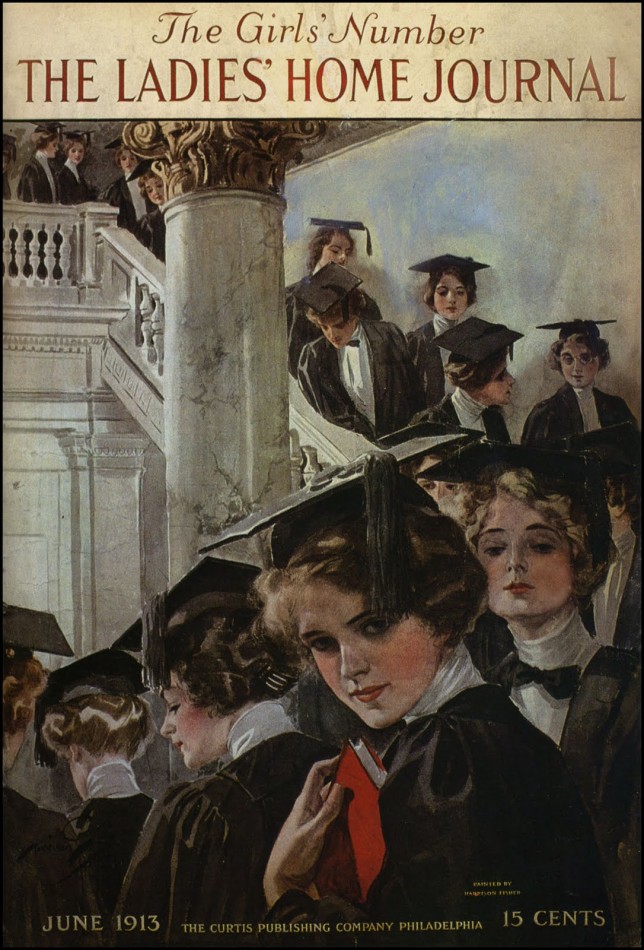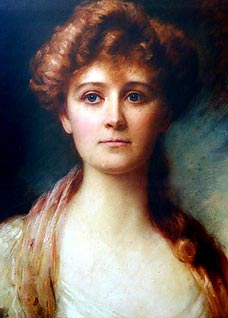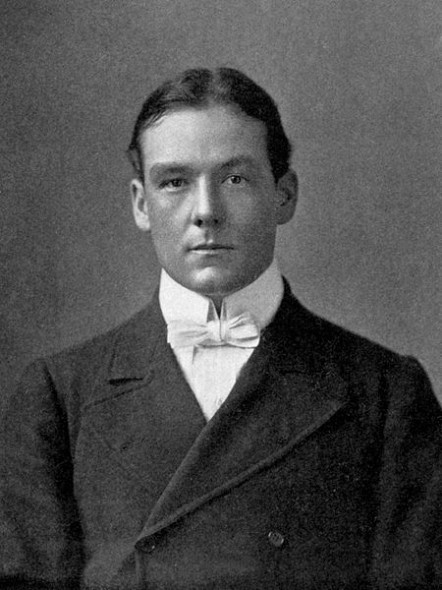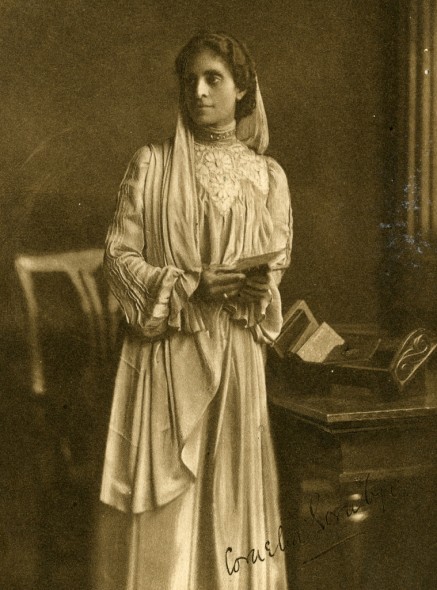
The word Bryn Mawr means high hill, and the college was named after the town five miles west in the suburbs of Philadelphia, on the main line of the Pennsylvania Railroad. Its site is four hundred and twenty feet above sea-level, in the midst of a beautiful rolling country, made easily accessible in every direction by good roads. The college grounds cover fifty-two acres, and include lawns, tennis-courts, a large athletic-field, and a skating-pond.
If first seen on a quietly brooding spring day, when the ground is blue with violets, and the blue and white “fair weather” signal flags are flying from Dalton Hall, the beauty of Bryn Mawr is a thing never to be forgotten. Far off in the distance, over the undulating hills, is a stately white marble residence with red tiled roof; in the middle distance is an attractive group of professors’ houses; somewhat nearer stands out “Low Buildings,” where the members of the faculty have cozy apartments and live a very serene, happy life; directly before one are Merion, Radnor, Denbigh, and Pembroke, the last-named an imposing structure of gray stone, with a central arch through which one views a very pleasant vista of shady green. The newest residence hall is Rockefeller, just completed this spring. It adjoins Pembroke Hall West, and its central tower, known as the Owl Gate, forms, for foot-passengers, the permanent entrance to the college.
Bryn Mawr College was founded by Dr. Joseph W. Taylor, of Burlington, New Jersey, a man who, though a bachelor, had all his life taken a great interest in the education of women. He died January 18, 1880, leaving the greater portion of his estate for the establishment and maintenance of this institution of advanced learning. It was his earnest desire that the college should be pervaded by the principles of Christianity held by Friends, which he believed to be the same in substance as those taught by the early Christians, and an endeavour has accordingly been made to promote this end. In the social life of the college to-day interesting little traces of its Friend origin are discerned; there is never any dancing at Bryn Mawr, for instance. And its chapel has about it nothing that would distinguish the room from an ordinary lecture-hall.
Before actual work was begun at Bryn Mawr, the organization of Vassar, Smith, and Wellesley was carefully studied. To the Johns Hopkins University, however, is due the academic system which was finally adopted, a scheme of major and minor electives in fixed combination, to which Bryn Mawr gave the name of the group system. In the spring of 1885 the first programme was issued, and that same autumn the college regularly opened for instruction. From the start Bryn Mawr has maintained distinctly high rank. No college women in the country are more thoroughly trained and have a more scholarly type of mind than those who take degrees here. Having said which, one may perhaps pass at once to the institution’s social side, even though, in so doing, one does run the risk of not giving a large enough degree of prominence to the thing which, above all others, makes Bryn Mawr what it is, i. e., its really austere academic life.
The only kind of hazing ever indulged in at Bryn Mawr comes early in the year, when the sophomores try to spirit away the new caps and gowns which the proud freshmen have just purchased. The game is for the freshmen to find their precious robes. When, therefore, they are able to come in to chapel dressed in their newly-attained habiliments, they are warmly congratulated by the president “upon having successfully matriculated.” The girls never renew their caps and gowns, a senior being justly proud of a well-worn cap and a rusty gown. Even at Commencement the same old gowns are worn over fresh white duck skirts and white shirt-waists.
A question very commonly addressed to the Bryn Mawr girl by a stranger at the college is, “Why do you have a lantern on your college pin?” Acquaintance with the customs and life of the place makes one concede, however, that the lantern is a singularly appropriate emblem to be so used. For almost the first association an entering student has is with lanterns. And the lantern is likewise linked with her final impressions of her Alma Mater.
One of the oldest and most characteristic customs is the Presentation of the Lanterns. The ex-freshmen then greet the incoming girls with a song, and present each one with a “lantern to light her steps through the unknown ways of college life,” and especially through the mazes of the group system. Sometimes much sage advice is given with the light, and once the unfortunate freshmen won their lanterns only after passing an impromptu oral examination. The form of the affair differs with the character and resources of the class giving it; but as preparations for it are begun in the freshmen year, the offering is usually both clever and original.
The farewell lantern celebration is at the alumnae supper given on Commencement evening. Here a speech of welcome is made to the new alumnae, and at the close of the festivities the lights are turned low, and the lanterns, standing at each place, are lighted from one large lantern that has been burning throughout the evening at the head of the table. Holding the lighted lanterns, the alumnae sing the old college song. Then they slowly go out, leaving their bright lights still burning on the deserted board.
Short as has been the life of Bryn Mawr, there is already connected with it a wealth of interest and tradition. Each class has a seal, a dolphin, a beaver, or some other animal, which every member wears in ring form, and in the use of the lanterns not a little originality and ingenuity have been displayed. The first lantern, pointed out to the visitor of to-day with impressive reverence by the undergraduate, was a plain little candlestick. From then up to the present time, every sort of lantern has been used. All the residence halls — except the newest one — bear the names of Welsh counties, a thing which of itself gives charm and atmosphere to Bryn Mawr. The views from these halls are in every case fine and inspiring.
The students’ rooms in the halls are many of them arranged in double suites, two bedrooms and a common study. In Pembroke the suites are particularly attractive, as are also the parlour and the reception-room. The dining-room at Pembroke is over the imposing central arch, and, finished as it is with dark wood and equipped with handsome high-backed chairs and dainty table fittings, it forcefully impresses one as quite all that such a room in a girls’ college should be. At the end of the room are two fireplaces, one on each side. Over these are carved respectively the legends Ung ie Seruiray and Veritatem Dilexi. The table at Bryn Mawr is uniformly good, dinner being, of course, the meal of the day. This is a social occasion, and all the girls dress for it as carefully as if they were in their own homes. The college gown, which is the regular academic garb, is never worn then.
This year, for the first time, the tuition fee is $200 for undergraduate students. Other expenses bring the price of a year at Bryn Mawr up to not less than $500 for undergraduates and $400 for graduate students. Here, however, as in many other of the leading educational institutions for women, there are ways of helping girls to help themselves. Some of these ways are exceedingly interesting. A lunch room in the gymnasium is conducted by students; there are electrical lieutenants in every building, whose duty it is to regulate the matter of lights; a college book-shop has students for clerks, and a captain of the fire-brigade directs drills for each residence hall.
Chapel, held every day at a quarter before nine, is voluntary, but the students go in large numbers. On Sundays the girls attend such churches in the neighbourhood as they may elect, and every other Wednesday evening there is a sermon at college by some distinguished clergyman, the alternate Wednesdays being given over to a Christian Union service, conducted by the students themselves.
Gymnasium attendance is required at Bryn Mawr, as are also four periods of exercise each week. One hour only of this is class drill, however, the rest of the time being divided between golf, riding, swimming, hockey, or basket-ball, all of which count as exercise.
Undergraduate work at Bryn Mawr is all over by four in the afternoon, so that there is a very fair margin of leisure for the girls to enjoy. This they do in fine weather by means of teas on the lawn, the wardens of the various halls being “at home” on different days to the student body. Singing on the steps of Taylor Hall (which belong to the seniors) is another favourite diversion, a thing not only delightful in itself, but useful, too, as practice for the garden-party occasion, which crowns the senior year, and for the farewell to the halls and the faculty which comes after the seniors’ last lecture.
Into the last week of the college year are crowded many gaieties. The first of these is the senior class supper, a distinctly impressive occasion when everything that has marked the career of the outgoing class is brought up and enjoyed, old jokes repeated, old stories retold, and every endeavour made to mitigate the sadness which must otherwise attend a farewell. At the end, the class, standing, sings its own song and gives its cheer. When the feast is all over, some of the fragments that remain are sent to the honorary members of the class, — those of the faculty who first came to Bryn Mawr the year that class entered college.
At high noon, on the day before Commencement, a breakfast is given to the seniors by the other students. This is held in the gymnasium, decorated with daisies and boughs set off by the yellow and white of the class banners. The toasts are followed by chorus singing of college songs. Then, before college breaks up, the seniors hand over to the lower classes their duties and responsibilities, and make a tour of the buildings, which they serenade in turn. And on Commencement morning, as a last loving attention, the freshmen make for their departing big sisters countless daisy chains, which are used to decorate the chapel and the hallways.
For the Garden Party of Commencement Week, the most ornate festivity of the college year, the girls all have beautiful new gowns. Their friends from outside are invited out in large numbers, the buildings are illuminated, the trees hung with Japanese lanterns, and Bryn Mawr is for the nonce transformed into the gayest of fairy-lands. The evening always ends by singing on Taylor House steps, and the song which forms the last number on the programme is that called ” Our Gracious Inspiration,” written by Caroline Foulke, of the class of ’96.
— The College Girl of America (1905) by Mary Caroline Crawford




It’s so funny to read this because I live just down the road from Brynn Mawr, I’ve even played field hockey on their “large athletic-field”!
How neat! I wonder if they allow visitors to tour the building.
I am a Bryn Mawr alumna. The campus has tours. If you walk into the Admissions Office, you can take a tour with a guide. Or you can just walk around the campus on your own.
Thanks AT!
Very interesting article, thankyou – and what a delightful illustration of intelligent, serious, lovely womanhood. Especially poignant when we know what the coming years held for them.
Definitely. The book I quoted from has a chapter about “what next?” for these women college graduates. It seems that it took a couple of decades (the 1970s or 80s?) before a college degree meant something for a woman’s future, as opposed to biding time between childhood and marriage.
I wrote with especial reference to the Great War…
Oh, well, WWI didn’t impact Americans as much as it did Britons and Europeans (we didn’t get in until 1917, and significant numbers didn’t appear on the Front until spring 1918), so there was no foreboding over the coming years for American women in colleges! 🙂
Very interesting read. I have never seen an all-girls’ university and I wonder why Dr. Joseph Taylor wanted it that way. Did he believe that if males were allowed in, they would harm the women? Or divert the women from their studies? How did young men and women from the various universities meet potential marriage partners?
There were co-ed schools in the US and in the UK; however, colleges like Bryn Mawr, Smith, and other “Seven Sisters” (or Newnham, Girton, etc at Cambridge and Oxford) were set up as female counterparts to the top male colleges (Harvard, Princeton, Yale, etc).
How lovely! I’m a Bryn Mawr grad, and this is making the rounds of us all on Facebook. It’s wonderful to see what’s stayed the same – lanterns, Step Sings, Garden Party, great food, compulsory PE – and what’s changed. I’d have loved to pay $200 for classes to end at 4pm!
Bryn mawr means “big hill,” not “high hill.”